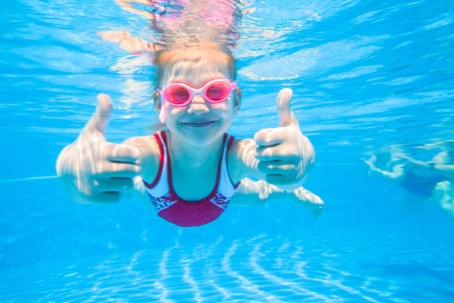Going for a dip in the pool is a great way to beat the summer heat—but it can also be deadly, especially for young children. As we are in the midst of summer, we believe that this is a great time to review the basics of water safety so that parents and caregivers can take steps to prevent potential drowning accidents.
Here are four general tips to reduce the risk of drowning in any swimming environment:
1. Teach Children How to Swim
Learning to swim should be a priority for every family member. Specifically, ensuring that young children learn the basics of swimming from a young age can help them stay safe in the water.
According to the American Academy of Pediatrics (AAP), water survival skills training and parent-child swimming lessons should start for children aged 1-4. Once a child turns 4 years old, they should be able to take real swimming lessons to learn paddling, floating, treading water and getting to an exit point.
2. Always Have a Sober Adult Supervising
Remember that swimming lessons are not a substitute for adult supervision. All children and adolescents should be supervised while swimming or playing in the water, even if they know how to swim.
An appropriate water watcher is someone who is at least 16 years old, understands how to recognize signs of distress, knows CPR, has a phone in order to dial 9-1-1, has a floating object needed for rescue, and is completely sober.
3. Implement Safety Measures With Backyard Pools
More than half of childhood drownings occur in pools at the child’s own home. If you have a backyard pool at your residence, ensure that you implement the right safety measures needed to prevent your child from jumping in unsupervised or accidentally falling in. For instance, you should:
- Install a fence that is at least four feet tall around the entire perimeter of the pool/spa.
- Use a pool alarm that runs along the perimeter of the wall or fence surrounding the pool and alerts you if there is anything or anyone in the water.
- Ensure that the gate/fence is secured with a child-proof lock.
- Don’t leave toys in the pool, as a child may accidentally fall in while retrieving the toy.
4. Be Aware of the Telltale Signs of Drowning
Many people believe that drowning looks like a person flailing their arms up in the water and yelling for help. But contrary to popular belief, drowning often occurs swiftly and silently. Therefore, it’s crucial that you understand the telltale signs of drowning so you can take immediate action if someone is in trouble underwater:
- Head low in the water with mouth at water level
- Head tilted back with mouth open
- Eyes glassy and empty, unable to focus
- Eyes closed
- Looks to be climbing an invisible ladder
- Trying to swim but making no progress
- Hair over forehead or eyes
- Not using legs and vertical in the water
Was Your Child Harmed in a Swimming Pool Accident?
If your child is injured in a swimming pool or drowning accident that occurs on another person’s property or due to negligent supervision, you may be entitled to compensation for your family’s medical expenses, lost wages, pain and suffering, and more.
We hope that you never need a personal injury attorney, but if you do, know that Law Offices Of Vic Feazell, P.C. is standing by ready to provide your family with the compassionate, personalized legal representation you deserve.
Contact our firm at (254) 938-6885 to speak with our legal team for free today! We offer free consultations and clients pay no out-of-pocket fees to retain our legal services.

